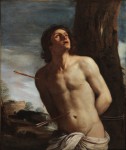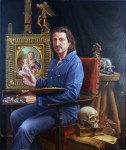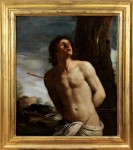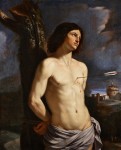 A long-lost painting of Saint Sebastian by 17th century Baroque master Guercino that was found by actor Federico Castelluccio, aka mobster Furio Giunta on The Sopranos, is going on display in the United States for the first time. Its exhibition at the Princeton University Art Museum is only the second time the painting has been on display since its rediscovery. It made its world debut at an exhibition dedicated to depictions of Saint Sebastian at the Castello di Miradolo museum in Turin last October. Guercino’s work scored top billing over the likes of Titian and Rubens as the cover picture of the show.
A long-lost painting of Saint Sebastian by 17th century Baroque master Guercino that was found by actor Federico Castelluccio, aka mobster Furio Giunta on The Sopranos, is going on display in the United States for the first time. Its exhibition at the Princeton University Art Museum is only the second time the painting has been on display since its rediscovery. It made its world debut at an exhibition dedicated to depictions of Saint Sebastian at the Castello di Miradolo museum in Turin last October. Guercino’s work scored top billing over the likes of Titian and Rubens as the cover picture of the show.
 Castelluccio, who in addition to his acting credits is also an accomplished realist painter in his own right and a collector of Renaissance and Baroque Italian paintings, found this masterpiece the way they’re found in art nerd fairy tales. He was driving through Frankfurt in 2010 when a window filled with paintings caught his eye. It was the Dobritz auction house, a small local shop crammed with works scheduled to be sold at an auction in two weeks. In a stack of paintings on the staircase to the second floor of the shop, Castelluccio saw the Guercino. It immediately leapt out at him as the work of the Baroque master, the fine chiaroscuro belying the auction house manager’s lackluster description of the piece as “an 18th-century Italian holy painting of Saint Sebastian.”
Castelluccio, who in addition to his acting credits is also an accomplished realist painter in his own right and a collector of Renaissance and Baroque Italian paintings, found this masterpiece the way they’re found in art nerd fairy tales. He was driving through Frankfurt in 2010 when a window filled with paintings caught his eye. It was the Dobritz auction house, a small local shop crammed with works scheduled to be sold at an auction in two weeks. In a stack of paintings on the staircase to the second floor of the shop, Castelluccio saw the Guercino. It immediately leapt out at him as the work of the Baroque master, the fine chiaroscuro belying the auction house manager’s lackluster description of the piece as “an 18th-century Italian holy painting of Saint Sebastian.”
It was estimated to sell for between 1,000 and 1,500 Euros ($1,100 – 1,657), which obviously Castelluccio was more than glad to pay on the spot, but the manager insisted that he attend the auction and bid for it like anyone else. When the actor actually showed up, flying back to Frankfurt from his home in New York specifically to bid on that Saint Sebastian, the manager got an inkling that they might have something a little more interesting than some anonymous 18th century holy painting. Someone else apparently had a similar inkling, because Castelluccio wound up in a duel with a phone bidder that drove the final hammer price up to 49,000 Euros ($54,000). Castelluccio and his business partner put in the winning bid.
 Then came the hard work. Castelluccio instinctively believed the painting was an authentic Guercino, not the work of his studio or a later reproduction, but one man’s good taste is not an accepted authentication standard. First the painting was cleaned, conserved and suitably framed. This painstaking process took years during which Castelluccio did assiduous research on the painting’s history. Art historians and leading Guercino experts David Stone of the University of Delaware and Nicholas Turner, the former curator of drawings at the J. Paul Getty Museum, were enlisted to thoroughly examine the work. They used X-rays, infrared reflectography and chemical pigment testing to determine the painting’s age and to compare its bones to those of known works by Guercino. They authenticated it as painted by Guercino’s hand around 1632-34.
Then came the hard work. Castelluccio instinctively believed the painting was an authentic Guercino, not the work of his studio or a later reproduction, but one man’s good taste is not an accepted authentication standard. First the painting was cleaned, conserved and suitably framed. This painstaking process took years during which Castelluccio did assiduous research on the painting’s history. Art historians and leading Guercino experts David Stone of the University of Delaware and Nicholas Turner, the former curator of drawings at the J. Paul Getty Museum, were enlisted to thoroughly examine the work. They used X-rays, infrared reflectography and chemical pigment testing to determine the painting’s age and to compare its bones to those of known works by Guercino. They authenticated it as painted by Guercino’s hand around 1632-34.
 There are only two other life-size, three-quarter view Saint Sebastians by Guercino known: a 1641 version now in the Moscow’s Pushkin Museum and one in the Museo de Arte de Ponce in Puerto Rico. The newly rediscovered one is the earliest of the three. While Castelluccio and his partner wound up spending about $140,000 total in acquiring, conserving, testing and researching the painting, if they were to sell it now it would certainly make millions. A King David by Guercino sold at Christie’s in London for close to $8 million (including buyer’s premium) and that was in 2010. The Christ and the Woman of Samaria bought privately by the Kimbell Art Museum that same year is thought to have gone for more than $10 million.
There are only two other life-size, three-quarter view Saint Sebastians by Guercino known: a 1641 version now in the Moscow’s Pushkin Museum and one in the Museo de Arte de Ponce in Puerto Rico. The newly rediscovered one is the earliest of the three. While Castelluccio and his partner wound up spending about $140,000 total in acquiring, conserving, testing and researching the painting, if they were to sell it now it would certainly make millions. A King David by Guercino sold at Christie’s in London for close to $8 million (including buyer’s premium) and that was in 2010. The Christ and the Woman of Samaria bought privately by the Kimbell Art Museum that same year is thought to have gone for more than $10 million.
He and the co-owner may eventually sell the portrait, [Castelluccio] said, ideally to a prestigious institution.
A few of its previous owners have been identified, including the German countess Maria von Maltzan, a Resistance fighter during World War II who hid Jews and other escapees from the Nazis.
Once the painting was authenticated, art dealer Robert Simon, to whom Castelluccio had shown the work before it was cleaned, arranged for its loan to the Castello di Miradolo where Guercino’s Martyrdom of Saint Sebastian was seen in the public again after 350 years in obscurity. Castelluccio got it back after the exhibition closed in March and then Princeton reached out to him to see if he’d be amenable to a more local exhibition. He was and now the painting is on display at the Princeton University Art Museum as a special installation until January of 2016.
This is wonderful, wonderful news. It takes a bit of luck plus a ‘trained eye’, patience and an appreciation of art to find these treasures, occasionally lost amongst the mysteries of time. I am especially delighted to read of HOW this particular artwork was RE-discovered. I have an interest in the saga and have a small oil of St. Sebastain along with a handsome Italian statue of him pierced with arrows. The sad fate of the Saint calls for a dramatic pose – and hence, his life’s end is hauntingly memorable. I too, am in hopes this painting will eventually be located where thousands and thousands of visitors can view it again.
…and the ‘Oscar’ for best-paining actor goes to .. Don Furio !!!
Honestly, not bad at all – and better than anything that I could have done.
Only the colors appear a bit ‘chalky’, i.e. the garments and fabrics look good, but e.g. the black background does not really convince me here.
Also, even more artistic freedom would possibly be no mistake (Duerer for reference, who probably did not own a digicam and depicted himself with a fur coat that -by the time he was painting it- he was not even entitled to wear).